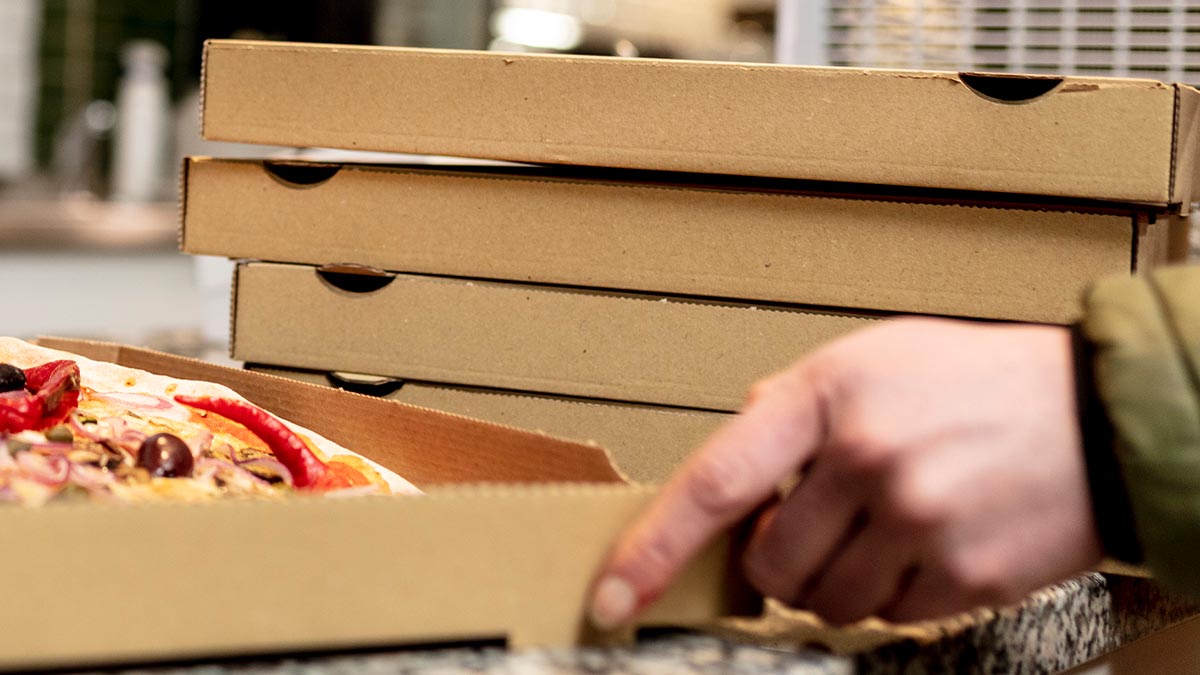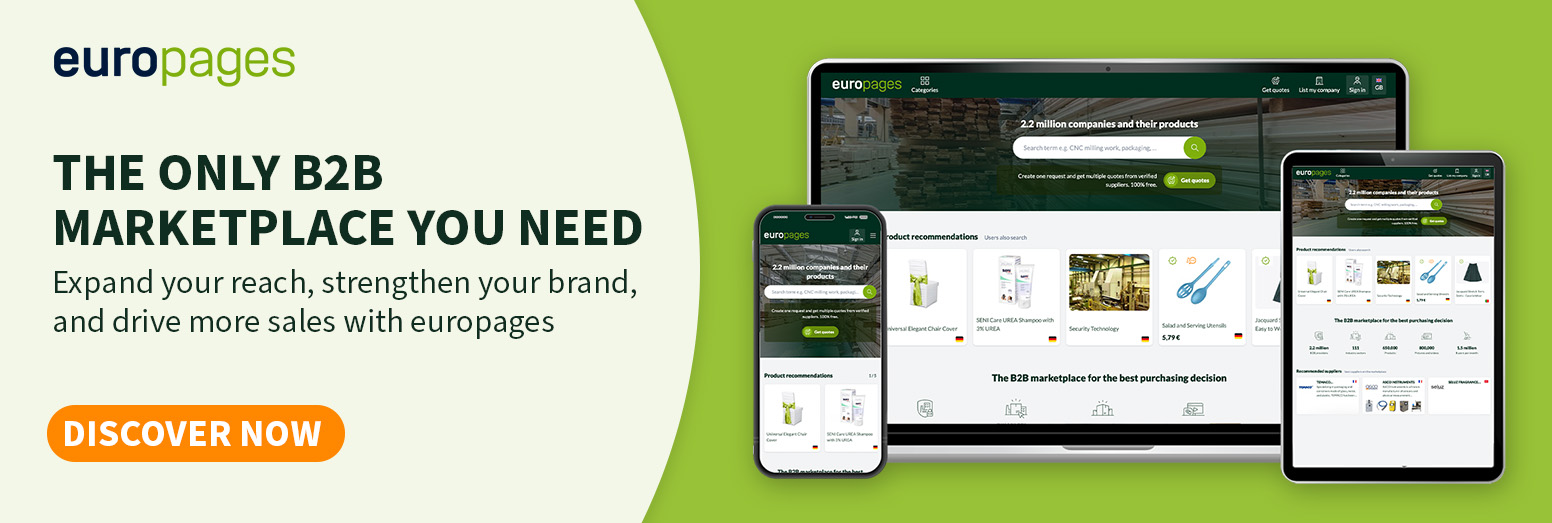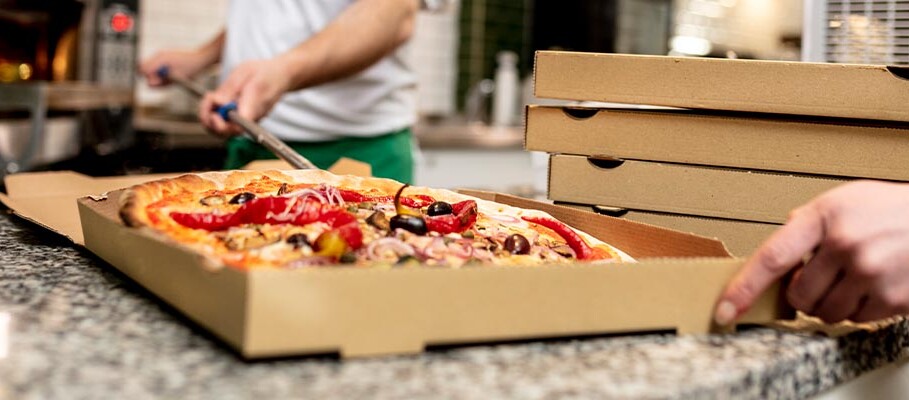Table of Content
- Why is Takeaway Packaging Changing?
- Sustainable Pizza Box Options: Balancing Cost and Conscience
- How Pizza Box Design Improves Customer Satisfaction
- Smart Takeaway Packaging: Technology’s Role in Delivery Efficiency
- Solving Storage and Handling Issues: The Right Takeaway Packaging
- Pro Tip: The Marketing Power of the Pizza Box
- The Future of Takeaway: What's Next After the Pizza Box?
- Conclusion
1. Why is Takeaway Packaging Changing?
Takeaway packaging has come a long way. It started with simple paper bags and basic containers, but now there are many different materials and designs. At first, the main goal was just to hold and transport food. Restaurant suppliers had fewer choices, and cost was the biggest concern.
But things have changed because of several key factors:
- The Growth of Delivery Services: With more third-party delivery platforms, the number of takeaway orders has increased a lot.
- Higher Customer Expectations: People now expect their food to arrive hot, fresh, and in perfect condition, which means packaging has to perform better.
- Environmental Concerns: More awareness about plastic waste and pollution has created demand for eco-friendly packaging supplies.
- Branding Potential: Businesses are realizing that packaging isn’t just practical—it’s also a marketing tool that helps extend the brand experience beyond the restaurant.
Because of these changes, restaurant suppliers and packaging manufacturers have had to innovate. The classic pizza box is still common, but it’s no longer the only choice.
New materials, designs, and technologies are making packaging more sustainable, efficient, and customer-friendly. But what are the real benefits of these changes?

2. Sustainable Pizza Box Options: Balancing Cost and Conscience
Sustainability is no longer just a trend—it’s an important part of doing business. More and more consumers care about their environmental impact and expect businesses to do the same. This is especially important for takeaway packaging, which is often used once and then thrown away.
The pizza box is a great example of this challenge. It’s usually made from corrugated cardboard, which is affordable and keeps food warm. But making cardboard uses a lot of resources, and grease stains can make recycling tricky.
Here are some alternative options:
- Recycled Cardboard: Pizza boxes made from recycled materials help reduce the need for new resources. Many businesses can make this switch easily, but availability and cost can vary.
- Compostable Materials: Some packaging is made from plant-based plastics (PLA) or bagasse (sugarcane fiber) that break down naturally under the right conditions. However, they require special composting facilities, which aren’t available everywhere. For example, a compostable pizza box might seem like a great option, but if not processed correctly, it can contaminate other recyclable materials.
- Reusable Packaging Systems: Some businesses are testing reusable containers with a deposit and return system. This cuts down on waste but requires major changes in logistics and customer participation.
Switching to sustainable options has clear benefits: it helps the environment, improves brand reputation, and can save money over time.
But there are challenges, too:
- Higher Upfront Costs: Sustainable materials often cost more than traditional ones.
- Availability Issues: Finding reliable restaurant suppliers for sustainable packaging can be difficult in some areas.
- Recycling and Composting Limitations: Not all locations have the right facilities to handle these materials properly.
Even with these challenges, the shift toward sustainable takeaway packaging is happening. Businesses need to weigh the costs and benefits to find solutions that match their values and operations.
For more information on the evolving regulations impacting packaging waste and circularity within the European Union, refer to the Packaging and Packaging Waste Regulation (PPWR): Regulation - EU - 2025/40 - EN - EUR-Lex
3. How Pizza Box Design Improves Customer Satisfaction
A pizza box is more than just packaging—it’s part of the overall dining experience.
Well-designed packaging can improve the dining experience in several ways:
- Better Heat Retention: Features like double-walled construction or special vents help keep pizza hotter for longer.
- More Eye-Catching Presentation: Custom printing, creative designs, and unique shapes make the box more visually appealing.
- Added Convenience: Built-in plates, tear-away sections, or handles make it easier for customers to eat their pizza on the go.
- Interactive Features: QR codes, games, or other fun elements can engage customers and make the experience more memorable.
These upgrades can make the product feel more valuable, improve customer satisfaction, and strengthen a restaurant’s brand. For example, a pizza box that turns into a serving tray means no extra plates are needed—perfect for picnics or outdoor meals. A custom-designed box with a restaurant’s logo and colors helps reinforce brand identity.
Investing in a better pizza box design shows attention to detail and a commitment to quality. However, it’s important to balance creativity with practicality and cost.
Does an innovative design always mean higher production costs? Not necessarily—it depends on the materials and production methods used.
Are you a restaurant supplier looking for more exposure? Our team can help you to reach new customers. Request a consultation to learn more.

4. Smart Takeaway Packaging: Technology’s Role in Delivery Efficiency
Technology is becoming a key part of takeaway packaging, offering more than just a way to hold food.
Some examples include:
- Temperature Monitoring: Sensors in packaging track food temperature during delivery to ensure it stays just right.
- Tamper-Evident Seals: These seals show if the packaging has been opened, increasing food safety and customer trust.
- RFID Tags: These tags help track inventory, improve logistics, and reduce order mistakes.
- QR Codes: Customers can scan these to access nutrition details, special offers, or interactive content.
For businesses, these innovations bring several benefits:
- Better Food Safety: Temperature monitoring and tamper-evident seals help ensure food stays safe to eat.
- More Efficient Operations: RFID tags and tracking tools help streamline processes and minimize errors.
- Valuable Data Collection: Smart packaging can provide insights on delivery times, temperature changes, and customer preferences.
- Marketing Potential: QR codes and interactive features engage customers and strengthen brand connection.
While smart packaging is still developing, it has the potential to transform the takeaway industry. It could improve efficiency, boost food safety, and create a more engaging customer experience.
Will this technology soon shape the future of restaurant supplies?
5. Solving Storage and Handling Issues: The Right Takeaway Packaging
Efficient takeaway packaging isn’t just about looks or sustainability—it also plays a big role in a restaurant’s daily operations. Packaging that is easy to handle, stackable, and space-saving can make a real difference in workflow.
Here’s why it matters:
- Easy Assembly: Pizza boxes and containers that fold quickly save time and reduce labor costs.
- Stackability: Well-designed packaging takes up less space and makes transporting large orders easier.
- Space-Saving Design: Compact packaging helps reduce storage needs and lowers shipping costs.
- Standardized Sizes: Using consistent packaging sizes simplifies inventory management and reduces the risk of ordering mistakes.
Small details like these can have a big impact on a restaurant’s efficiency and costs. Choosing the right packaging supplies can help businesses save time, cut waste, and improve overall operations. For restaurant suppliers, offering smart packaging solutions can be a major advantage.
Are you looking for a packaging supplier for your restaurant? Request a quote on our website to find the ideal business partner.

6. Pro Tip: The Marketing Power of the Pizza Box
The pizza box is more than just packaging—it’s a marketing opportunity that goes straight into customers’ homes. Smart businesses are using it to boost their brand and engage with customers in creative ways.
One simple but effective approach is custom printing. Adding a logo, branding message, or even a special promotion directly onto the box helps reinforce brand identity. Another great tool is the QR code, which can instantly connect customers to a website, social media, or online ordering platform.
For even more engagement, consider including contests, giveaways, or exclusive discounts on the box design. Collaborating with other local businesses for cross-promotion can also turn the pizza box into a shared advertising space, benefiting both brands.
Rather than just thinking of it as packaging, see the pizza box as a cost-effective marketing tool. It’s an easy way to increase brand recognition, drive online traffic, and boost sales—all while delivering a great customer experience.
7. The Future of Takeaway: What's Next After the Pizza Box?
Takeaway packaging, including the pizza box, is always evolving.
So, what’s next? Here are some trends to watch:
- Greater Focus on Sustainability: Expect even more eco-friendly materials, reusable packaging systems, and efforts to reduce waste.
- Smarter Packaging: Technology will play a bigger role, with features like temperature monitoring, tamper-evident seals, and interactive elements becoming more common.
- Hyper-Personalization: Packaging could become more tailored to individual customers, with personalized designs or messages.
- More Automation: Robotics may handle more of the packaging and delivery process, making operations even more efficient.
- Drone Delivery: While still developing, drones could change how food is delivered, affecting the design and function of takeaway packaging.
The takeaway industry is always changing, and staying ahead of new trends is key for businesses to stay competitive. The pizza box, a long-time symbol of this industry, will continue to adapt to new demands.
These shifts will also impact restaurant supply and restaurant suppliers—it’s not a question of if, but when.
For more information about restaurant supplies, read these insightful articles:
- Enhance Customer Experience with Innovative Restaurant Packaging
- Restaurant Packaging: Boost Your Brand Identity
- Bespoke Catering Services with Sustainable Restaurant Supply
- Bespoke Catering Services in Restaurants
- Sustainable Soft Drink Packaging: Aluminum & Returnables
8. Conclusion
Big changes are happening in takeaway packaging, and it’s not just about function anymore. More and more, pizza boxes and takeaway packaging are designed to be eco-friendly, using materials like recycled cardboard and compostable options to help the environment.
But it’s not just about being green; packaging is also improving the customer experience, with designs that keep food hot, look good, and even include fun features. New technology is also playing a big role, with things like temperature checks and tamper-proof seals, which help both businesses and customers.
For restaurants and suppliers, offering efficient and smart packaging is becoming essential to save time, reduce waste, and cut costs. Even the simple pizza box can become a useful marketing tool, spreading a brand’s name into customers’ homes.
But what happens to the waste, even from the most sustainable packaging? While eco-friendly materials are a step forward, we need to think about what happens after we use them. Could we see a future where restaurants use reusable containers, even for pizza boxes?
This would need a lot of teamwork between restaurants, suppliers, manufacturers, and even customers. Picture a system where strong, easy-to-clean containers are used, returned, and reused, cutting down on single-use packaging. What would it take to make this happen, and how could we encourage people to use it? Moving to a fully reusable system could be the next big step in sustainable takeaway.
Find Takeaway Packaging Solutions for Your Project!
Sampackt Packaging: Offers comprehensive, eco-friendly packaging solutions, including customized food packaging, diverse bag options, doypacks, stretch film, and e-commerce envelopes, alongside advanced machinery and sustainable PCR granules. They deliver quality and environmental responsibility in every product, supporting businesses with recyclable materials and innovative composite solutions for global export.
SNI Pack: Established in 2004, is a leading Turkish manufacturer specializing in paper and cardboard packaging, including a wide range of bags, food boxes, and custom-printed solutions. With over 20 years of experience, they prioritize customer satisfaction by offering innovative designs, high-quality production using advanced technology, and tailored services to meet diverse packaging needs.
ArDelSan Packaging: Based in Turkey, provides high-quality, sustainable paper packaging solutions across various sectors, including cosmetics, food, and pharmaceuticals, offering retail, e-commerce, gift, food, and die-cut packaging. They prioritize eco-friendly practices, using recycled materials and customized designs to meet specific client needs, ensuring product protection and enhanced presentation.
İzol PACK: Established in 1977, specializes in rigid and folding box manufacturing, offering a wide array of packaging solutions for sectors like cosmetics, food, e-commerce, and retail, including paper and cardboard bags. With 45 years of experience, they prioritize customer satisfaction by providing customized designs and advanced printing services from their state-of-the-art facility.
Bleue Comme une Orange: Since 1978, Bleue Comme une Orange Packaging has provided comprehensive packaging design and production services, specializing in folding boxes and trays for industries including health, cosmetics, and food, utilizing advanced printing and finishing techniques. Their certified, human-scale operation offers quick turnaround times and manages projects of all sizes, ensuring product protection and enhancement with sustainable options.
The Kraft Packaging Store: Based in Guang Zhou since 2004, provides sustainable, food-safe, and cost-effective Kraft paper packaging solutions, including boxes and bags, to businesses and individuals globally. Offering both plain and custom-printed options with low minimum orders, they prioritize eco-friendliness and accessibility through flat-packing, efficient shipping, and small volume options.
Volutex Food: Is a French company specializing in the manufacturing and distribution of customizable, high-quality food packaging and hygiene products for catering and distribution professionals across France and Europe. They offer a wide range of items, including bowls, boxes, bags, disposable tableware, and consumables, with rapid custom production and delivery from their Île-de-France warehouses.
Pack Packaging Ltd: Is a leading UK manufacturer and distributor of food packaging for takeaways and restaurants. The company specializes in producing recyclable and biodegradable products, demonstrating its commitment to environmental protection.
FAOPACK: Is a leading manufacturer and supplier of innovative, flexible packaging solutions for diverse industries, offering products like custom-printed films, pouches, and laminates designed for superior product protection and shelf-life extension. Committed to sustainability, they provide eco-friendly options and work closely with clients to develop customized, high-performance packaging that meets stringent industry standards.
Kaya Packaging: This UK-based company manufactures high-quality, grease/leak-proof, recyclable, and microwavable paperboard and cardboard food boxes. They offer customization options including logo printing, bespoke sizing, and styles, providing large quantities at competitive prices.
Food Paper Portugal: Manufacturing since 2005, specializes in customized, biodegradable, and compostable food packaging made from certified food-grade paper and cardboard, including hot/cold food containers, recycled Kraft bags, and custom paper cups. They prioritize sustainability and client collaboration, using high-quality materials like virgin pulp and Kraft paper to create versatile, eco-friendly packaging for Take Away and Delivery services.
Colonna Packaging: With 20 years of experience, is a leading Italian supplier of MOCA and FSC certified food and industrial packaging, offering customizable, durable, and safe solutions, including paper, cardboard, plastic films, and accessories. They prioritize sustainability with recyclable options and serve diverse sectors, providing custom designs and extensive coverage across central-southern Italy.
ULAS GROUP: Is a leading food packaging company in France and Europe, manufacturing high-quality paper and cardboard products like boxes, bowls, lids, and straws. They offer customized packaging solutions, rapid implementation of bespoke processes through their in-house R&D, and prioritize quality, safety, flexibility, and efficiency for global clients.

